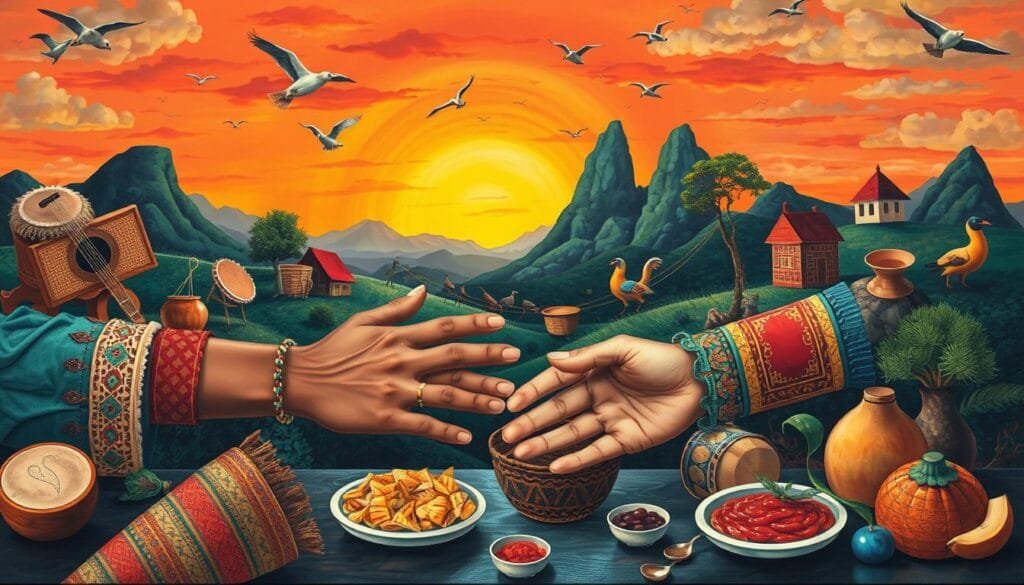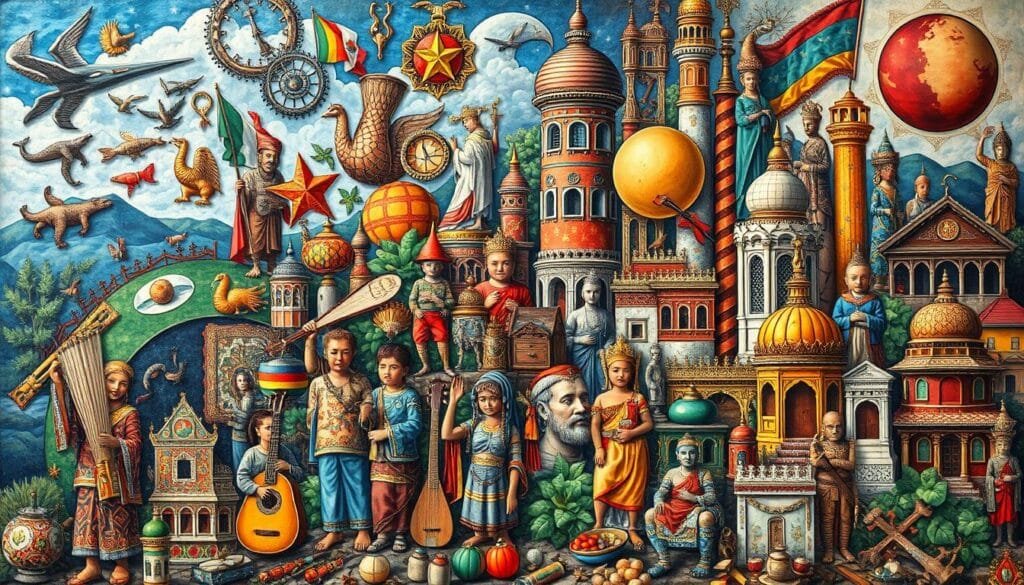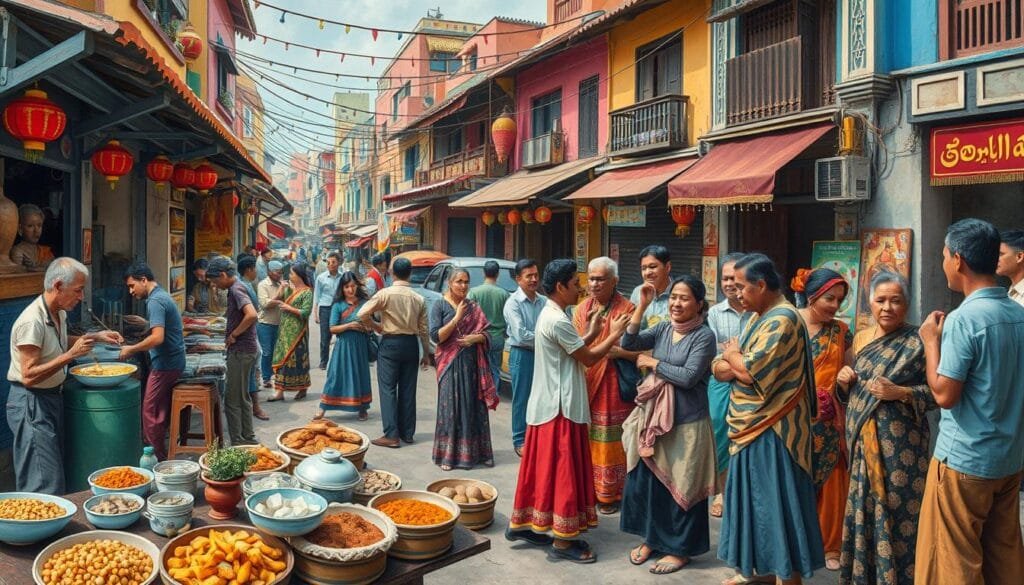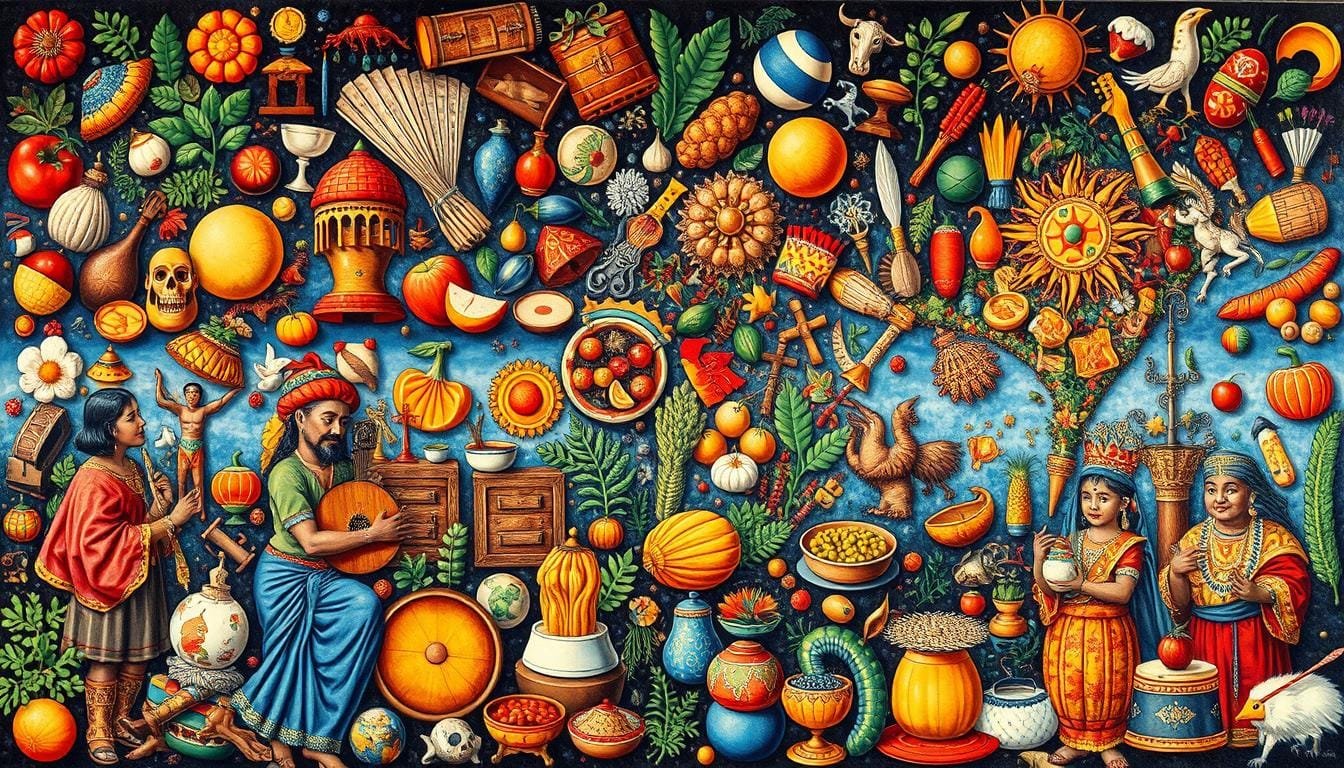Have you ever thought about the unseen forces that shape our lives every day? Culture involves learned behaviors, traditions, values, and symbols passed on through social learning. But what is culture really, and why is it so important?
Culture is essentially everything a society knows and does. It influences our behavior and the way we see the world. It’s not just about art or music. Culture includes our daily interactions, beliefs, and how we organize our lives. Edward Burnett Tylor defined it as a “complex whole” of knowledge, belief, art, morals, law, customs, and more, acquired by people as social beings.
Understanding culture is crucial in our diverse world. Teachers who understand their students’ cultures tend to see better academic performance. Students who feel accepted for their culture often do better in school. Our guide offers insights into American customs for international military students. It highlights the significance of adapting to new cultures.
Culture affects every part of our lives, from rituals and family dynamics to daily routines. Understanding culture’s components and its impact on communities is vital. Knowing culture helps us in social interactions and building communities.
Key Takeaways
- Culture is a complex whole, including knowledge, beliefs, art, and customs.
- Understanding students’ cultures can enhance their academic performance.
- Cultural practices shape everyday interactions and community structures.
- Cultural adaptation is crucial for effective community engagement.
- Diverse coalitions rely on unique strengths from different cultural groups.
Definition and Scope of Culture
Culture is a vast, complex concept that has fascinated scholars for many years. They have looked at it from both classic and modern viewpoints. Their goal was to understand the true depth and complexity of culture.
Classic Definitions of Culture
Edward Burnett Tylor gave a key culture definition. He said culture includes knowledge, belief, art, morals, law, custom, and more. It involves various elements humans embrace within their societies, showing culture’s diverse and intricate nature.
In 1952, A.L. Kroeber and Clyde Kluckhohn broadened this idea. They talked about 164 different definitions, from “learned behavior” to “statistical fictions.” Their work showed how cultural concepts evolved. They pointed out culture is an abstract idea, differing from psychology’s focus on concrete behavior.
Modern Interpretations of Culture
Culture today is seen as something that changes and adapts. Leslie A. White emphasized culture’s dependence on context. He believed it is about how societal elements relate, rather than just behavior. This view aligns with cultural evolution, which changes with human interaction and intelligence.
Current theories also look at culture’s evolution through different stages. These stages show the growth of human behavior over time. They highlight how human culture is unique, showing something not found in other animals. This cements our special cultural identity.
| Concept | Author | Key Ideas |
|---|---|---|
| Classic Culture Definition | Edward Burnett Tylor | Includes knowledge, belief, art, morals, law, custom. |
| Multiple Definitions | Kroeber & Kluckhohn | 164 definitions ranging from learned behavior to statistical fictions. |
| Dynamic Interpretation | Leslie A. White | Contextual dependencies and relationships among societal elements. |
| Evolutionary Stages | – | Simple reflexive, conditioned reflex, instrumental, and symbol stages. |
Elements that Compose Culture
Understanding culture’s elements is key to knowing human societies. Culture includes many parts, each adding something special to social life. We’re looking at four main elements: language and communication, beliefs and values, customs and traditions, and art and material objects.

Language and Communication
Language is crucial for cultural communication. It helps pass culture down. The Sapir-Whorf hypothesis says our concepts depend on our words. For example, the US has many words for “kiss,” unlike Japan. This shows how language shapes our society and interactions.
Using nonsexist language like “firefighter” over “fireman” promotes equality. It reshapes societal values. To learn more, visit Culture Elements.
Beliefs and Values
Beliefs and values are society’s ethical base. They define right and wrong. Take sexual behavior norms. The Pokot of East Africa and the Gusii have opposite views on women’s sexual enjoyment. In the US, we see formal laws and informal folkways, essential for order.
Customs and Traditions
Customs and ceremonies shape social norms and identity. Think of weddings, birthdays, and funerals. They link us to our past. Rituals are full of symbolism, preserving cultural stories. Experiments by Harold Garfinkel show that breaking norms teaches us about their power and our reactions.
Art and Material Objects
Art and objects show our cultural stories and history. From crafts to buildings, they express cultural pride and achievement. The difference between physical things like clothing and ideals like values shows our culture’s range.
Art also shows changing gender roles. Traditionally, men hunted and women gathered. Yet, in some cultures, both genders hunt. This highlights changing cultural roles.
Together, these elements weave the rich culture tapestry, bringing harmony to human life.
The Role of Symbols in Culture
Symbols play a key role in our cultures. They help express complex ideas and collective memories. Looking into cultural symbols shows us the values and shared experiences of societies. Symbols do more than represent; they create meanings that bring communities together.
Examples of Symboling in Human Behavior
Symboling is visible in various cultural elements, like language and rituals. The peace symbol (☮), created in 1958, stands for nuclear disarmament worldwide. The heart symbol (❤) means love and affection, especially in art and popular culture. Even with debates, English ties together many in the U.S., even though 13.8% speak another language at home (U.S. Census).
Religious symbols like the cross (✝), Star of David (✡), and Yin-Yang (☯) show deep beliefs and ethics. These symbols go beyond their physical appearance. They reflect the moral and spiritual values of societies.
Distinction Between Symboling and Symbolizing
Understanding symboling versus symbolizing helps us grasp symbolic interactions better. Symboling is about giving meaning within cultural norms. For example, many U.S. immigrants learn English but keep their original cultural symbols. Symbolizing, however, means creating or giving new meanings to symbols. Yoko Ono’s “Imagine Peace Tower,” started in 2007, is a symbol of peace in 24 languages.
Art like Pablo Picasso’s “Dove of Peace” and Salvador Dalí’s “Meditative Rose” shows how artists give new meanings to known symbols. Through these actions, cultural symbols remain essential. They communicate and unify by showing common human experiences and behaviors.
- Peace symbol (☮) – Nuclear disarmament
- Heart symbol (❤) – Love and affection
- Yin-Yang symbol (☯) – Balance of opposites
- Cross symbol (✝) – Christian faith
- Star of David (✡) – Jewish identity
What Is Culture: Human Uniqueness and Symboling
Culture’s core lies in special human traits. These traits let us go beyond simple reactions, creating a deep richness in cultural expression. A key skill that makes us stand out is symboling. This skill sets us apart from other species by letting us give and understand abstract meanings. It shapes our social life, language, rituals, and art.
Humans can naturally create symbols, changing the way we talk and express ourselves. Symbols are not just for talking. They are a key piece that shows our human traits. You can see this in our daily languages and in logos for companies.

Professor Hofstede called culture the “programming of the human mind” that makes groups different. Through this, we see that cultural expression mixes symbols, heroes, and rituals in complex ways. For instance, rituals like Independence Day or Thanksgiving show our culture’s patterns.
Cultural practices show how symboling and human traits play together. From marriage customs to how we travel, cultures shape and show our norms and responses. Common things like family or seeking food and shelter are foundations for unique cultural expressions.
| Element | Description | Examples |
|---|---|---|
| Symbols | Abstract representations carrying emotions and meanings | Logos, language systems, national flags |
| Rituals | Structured, repetitive activities marking significant events | Thanksgiving, Independence Day, graduation ceremonies |
| Heroes | Figures embodying societal values and ideals | Martin Luther King Jr., Mahatma Gandhi |
| Values | Core beliefs shaped by environmental influences | Importance of individual freedom, respect for elders, communal living |
Noam Chomsky talked about the common “deep structure” in human languages. This shows that symboling is universal. Even kids making up languages prove this point. Marvin Harris noted that all societies eat animal proteins and worship beings. This shows universal human culture aspects.
In summary, while cultures differ on the surface, deep shared traits and skills link us. The power to use symbols and shapes social practices is what truly makes human cultures unique. This adds to the complex and changing world we live in.
Culture in Everyday Life
Culture is woven into our daily lives, affecting how we act, believe, and interact. It shapes everything from our family to our global connections. To grasp culture in daily life is crucial.
Family Structures and Dynamics
How families work greatly influences a person’s views and daily cultural habits. Consider a child with immigrant parents, like a Mexican family in the U.S. This child lives in two cultures daily.
They learn from their family about education, college, and succeeding. This mixes traditional values with adapting to a new culture.

A child spends 75% of the next 15 years in school. Here, they see a culture different from their parents’. This shapes their social skills and who they become.
| Aspect | Parents’ Culture | School Culture |
|---|---|---|
| Language | Native Language | Predominantly English |
| Values | Traditional Values | Progressive Ideals |
| Social Norms | Community-Oriented | Individualism |
Rituals and Ceremonies
Rituals and ceremonies shape our daily cultural habits. Over 3,800 traditions have been noted by scholars. These events, like weddings and funerals, keep culture alive and build community.
Influence of Religion and Spirituality
Religion and spirituality guide society’s morals and worldviews. UNESCO-protected foods, like borsch and lavash, show how culture and religion are intertwined. They influence what we eat and how we celebrate our spirituality.
Cultural Globalization and Modern Society
Globalized culture brings different cultures closer through technology and the internet. In the past 30 years, this has opened up new cultural exchanges and ideas. The global fashion scene shows how clothes influence both the economy and culture.
It reflects changes towards inclusivity. Understanding these changes helps us keep our cultural identity in a connected world.
Conclusion
Understanding culture is key to knowing how societies develop. We see that culture has many parts. This includes language, beliefs, traditions, and art. Each part adds to the human experience.
In looking at symbols and global cultural trends, we learn about our shared humanity. It shows the complexity and depth of how cultures interact.
The Global Culture Report shows that small changes can make a big difference in work cultures. When workers have more freedom, they tend to be more creative and balanced. Learning new skills makes them loyal. Having understanding leaders helps teams stay strong.
It’s important for workplaces to have clear rules and a sense of community. This makes employees more engaged and perform better. It shows how valuable it is to understand culture in business plans.
To deal with different cultures, we must be open, respectful, and eager to learn. This helps the world be more united and cooperative. It also boosts societal growth.
By accepting the many sides of culture, we can see both the diversity and similarities among us. This leads to a richer human experience.
FAQ
What is the definition of culture?
Culture is about how people in a society behave and what they believe in. It covers traditions, values, and symbols shared through learning. It includes everything from art and morals to laws and customs, learned as part of a community.
What are the classic definitions of culture?
Edward Burnett Tylor saw culture as a mix of knowledge, beliefs, arts, and customs shared by people. A.L. Kroeber and Clyde Kluckhohn added to this, showing how culture’s meaning has grown over time.
How has the concept of culture evolved in modern interpretations?
Today, we see culture as ever-changing. Leslie A. White thought of it as shaped by its environment, made up of connections within society. He saw it as an evolving process driven by humans adapting and growing intellectually.
What elements compose culture?
Culture is made of languages, beliefs, traditions, and objects. Each part is key in shaping a society’s foundation.
How does language influence culture?
Language is key in passing culture along. It shares knowledge and traditions, affecting how societies think and act.
What is the importance of beliefs and values in culture?
Beliefs and values set the ethical foundation of societies. They guide choices and norms, shaping a community’s identity.
How do customs and traditions define culture?
Customs and traditions shape daily life and special events, marking a society’s identity. They highlight unique practices that bring people together through shared experiences.
What role do art and material objects play in culture?
Art and objects show a culture’s stories and heritage. From crafts to buildings, they symbolize cultural pride and history.
What is symboling, and how is it distinctive in culture?
Symboling involves using symbols to create shared meanings in a community. It’s more than just representing; it’s about interpreting and making new symbols together.
What is the distinction between symboling and symbolizing?
Symboling means giving meaning to cultural elements. Symbolizing is about making or changing symbols to share ideas in a culture.
How does culture demonstrate human uniqueness?
Our ability to create meanings shows our cultural uniqueness. Humans use symbols in advanced ways, leading to diverse languages, arts, and societies worldwide.
What is the role of culture in everyday life?
Culture shapes our daily lives, from family to society. It influences our beliefs and how we see the world.
How does cultural globalization affect modern society?
Cultural globalization mixes cultures, bringing new ideas and challenges. It’s about keeping identity while connecting globally.
